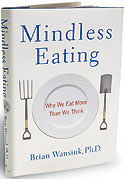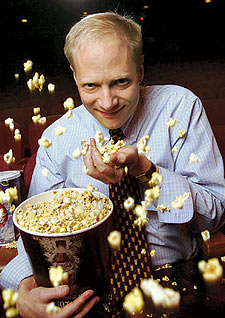by Jennifer Tanaka
Photograph: Megan Lovejoy  |
Two hundred fifty. That’s the number of food decisions Brian Wansink estimates the average person makes in one day. Cream cheese or butter? Fries? Would you like that wrapped? Under such an onslaught, it’s no wonder that we make up to 90 percent of our choices without thinking, says the 46-year-old food researcher. In a fascinating new book, Mindless Eating: Why We Eat More Than We Think (Bantam Books; $25), Wansink and his team of researchers at Cornell University’s Food and Brand Lab reveal our unconscious-and fattening-habits. Originally from Sioux City, Iowa, Wansink spent eight years at the University of Illinois at Urbana-Champaign perfecting his techniques for delving into the psychology of overeating. He talked to Jennifer Tanaka.
Q. Where do your research questions come from?
A. Observing people in everyday situations. People say, “I clean my plate all the time.” So you say, “What would happen if a plate never got clean?” And we invent the refillable soup bowl. Then people say, “I really overeat when I watch TV because I get so involved in the program.” Hmm; well, what would happen if you were watching a program that you thought was terrible? That’s one study that we’re doing today.
Q. Some of the assertions in the book-for example, that we eat more from big packages or serve ourselves more when using a big plate-struck me as obvious.
A. There are a couple of nonobvious things about that. One is that when it happens to a person they will say, “Oh, no. That plate didn’t influence me at all!” And we’ll say, “Well, wait a minute-here are the measurements. You put in 25 percent more.” And they’ll say, “The scale is wrong because I wouldn’t have overserved myself.” In the study, I took a graduate class at the University of Illinois and did a 90-minute lecture and demonstration of how bowl size influences people. These people, even though we pounded it to death, six weeks later, they ended up eating 50 percent more when they were given bigger bowls and bigger spoons than another group. These were nutritional science professors. If people who have been lectured to and people who study this all the time are influenced, then, as obvious as we want to say it is, it’s still pretty powerful.
Q. In one of your charts, you show how so-called reduced fat foods can have as few as four fewer calories than the regular version.
A. It’s ridiculous. A low-fat Oreo has 50 calories; a regular Oreo has 53 calories.
Q. In the case of the chicken noodle soup you cite, the low-fat version actually has more calories.
A. Yeah; isn’t that crazy? What ends up happening is that they have to replace the fat with things that taste good and sometimes they replace fat with sugar.
Q. Shouldn’t we feel duped?
A. We don’t read the labels. If we wanted a lower calorie version it would be, but we just want lower fat. But that’s the bad thing about these “health halos.” We really let ourselves fool ourselves.
|
Q. Who sponsors your research?
A. Just me. We turn down direct company sponsorship of the studies, because-and we don’t think it would bias it at all-it could give the appearance of bias. Then somebody might say, Wait a minute, if Kraft or Quaker Oats sponsored something, maybe there’s a bias, and we don’t think it should be taken seriously. Whereas right now, our research gets into some of the best journals in the field.
Q. I fear that snack food companies will use your findings to trick us into eating more. But do you think corporations are way ahead of consumers and researchers anyway?
A. No, I don’t, actually. I remember ten years ago, I went around to the companies and said, “Look, big packages make people overeat.” There’s a $40-billion diet industry out there that says if you come up with smaller packages-at the time, I called them mini packages-first of all, people are willing to pay a lot more for less food. You can make more money, and make people happier and less fat. So I went around to all these companies-Nabisco, M&M/Mars, Kellogg’s-and people went, “That’s ridiculous! Nobody’s going to pay for that!”
Q. That was the reaction across the board?
A. Across the board. I was pretty disappointed because I thought this was a great win-win way they could make money and make people skinnier. Or make people overeat less. And then about a year after, I got a phone call from a guy at Nabisco who said, “Is there a market for this?” Then a year after that, the same thing happened with Kellogg’s. It illustrated a couple things to me: that companies do a whole lot less in these new and innovative areas than consumers give them credit for, and also that things move pretty slow corporately when people get outside of the field in which they’re trained. This is really rethinking stuff.
Q. Were you offering them this information gratis?
A. Free!
Q. Which of the tricks to combat mindless eating do you personally use?
A. I use three different ones every month. I have a tendency to overeat at dinnertime so, for instance, one trick that I’m doing is only serving vegetables and salad family style and everything else we leave in the other room. For the office candy dish, I brought in gross stuff that I hate. The third thing I’m doing is for every ounce of soda I drink, I drink three ounces of water.
Q. Have you noticed any regional differences? The book seems to suggest that there aren’t any.
A. OK, so people in the South eat spicier food. I never found it interesting enough to really pursue. Cultures are much more similar than different.
Q. So the deliciousness of Italian beefs isn’t making Chicagoans fatter?
A. I don’t think so.
Q. Does the obesity problem in this country motivate you?
A. What’s actually motivating is that with very subtle changes we can make people’s lives better-without them having to obsess about food, without having to change the school system or the government. It’s not just getting people to eat less, but also eating more healthy or just enjoying it more. Yesterday, I saw this woman who was about six feet one and weighed about 130 pounds. She was probably only 25 years old and my thought was, as life goes on she’s always going to have this bizarre attitude toward food regardless of whether she gains weight. To help someone like that be somewhat liberated from an obsession about food-whether an obsession about not eating enough or being a bad person because she’s a little bit overweight-that’s more motivating.



